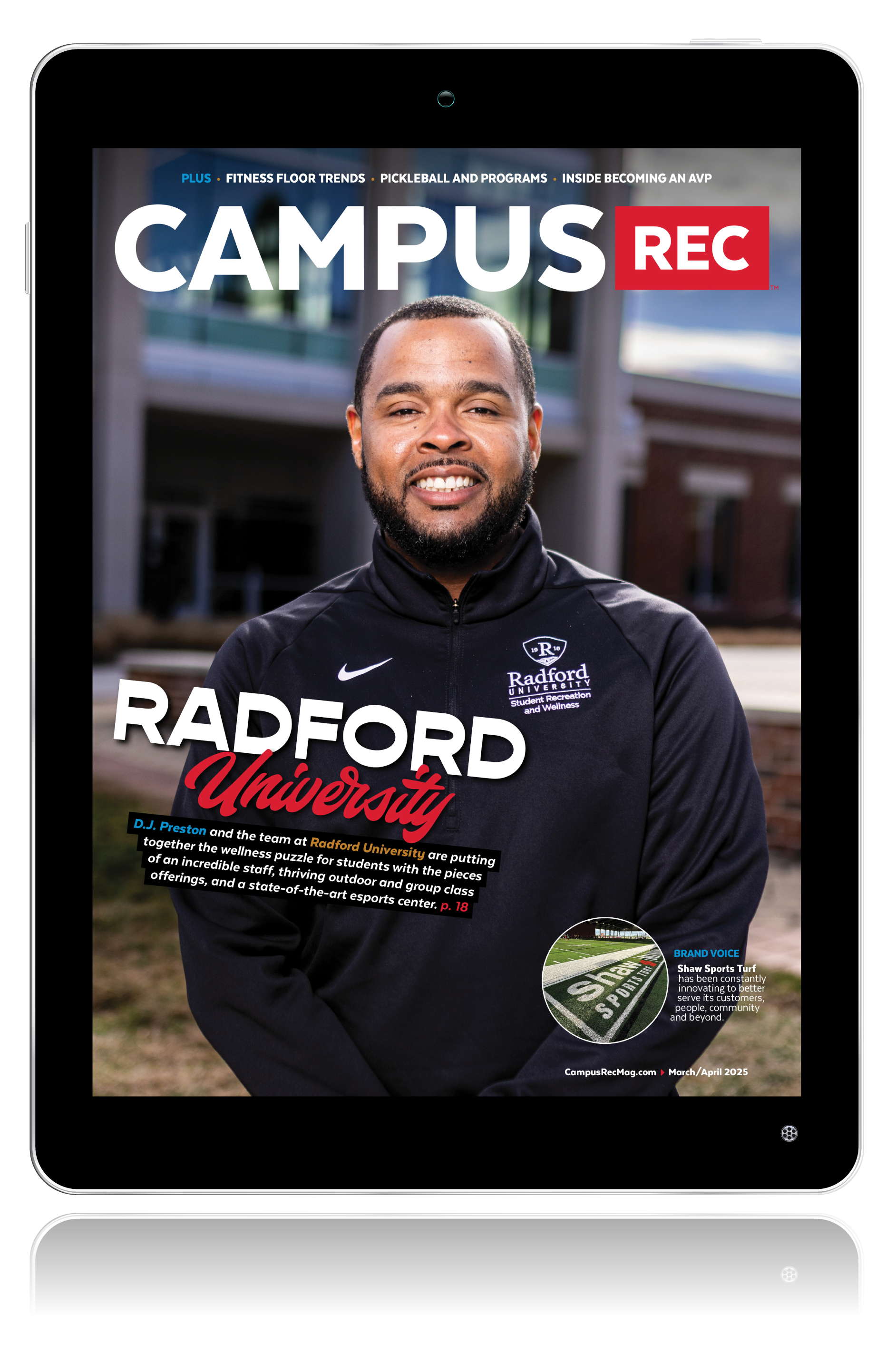
This is Part One of a three-part series on well-being. Caroline Dotts, the associate director for healthy lifestyle programs at Georgia Tech’s Campus Recreation Complex, shares on the way Georgia Tech’s Campus Rec (the CRC) is using CliftonStrengths to create a positive work environment. The series is meant for those that might be interested in doing something similar at their own schools to see how Georgia Tech accomplished it.
There is too much negativity in our culture today – too much focus on what’s not working; too much focus on how to improve our weaknesses; too much focus on what’s wrong.
But what if we flipped that script? What if we started focusing instead on what’s right? What if we changed how we talk to ourselves and to our teammates? How much more would we accomplish if we channeled our energy into maximizing all of the things we are doing well? How might our teams think, speak, and function differently if we started praising and appreciating each other for our successes and what we bring to the table?
How to Focus on What’s Right
The campus recreation department at Georgia Tech is on a quest to answer these questions through the lens of CliftonStrengths. Over the past four years, they have integrated theories and best practices of positive psychology through the CliftonStrengths approach into their work environment to create a thriving, caring and successful team.
Learning how to positively communicate and grow as an interdependent team is essential to success for any organization. Teams all across the globe are turning to CliftonStrengths to foster a universal, positive language that focuses on the strengths of the individual and of the team. So, what is it? CliftonStrengths – formally known as StrengthsFinder® – is a web-based, personality assessment created by Dr. Donald Clifton, said to be the grandfather of positive psychology. His idea was we all have talents we are born with, and with the right investment, we can turn those talents into strengths that set us up for success.
The Power of Strengths
According to the Positive Psychology Center at the University of Pennsylvania, positive psychology “is the scientific study of the strengths that enable individuals and communities to thrive. The field is founded on the belief people want to lead meaningful and fulfilling lives, to cultivate what is best within themselves, and to enhance their experiences of love, work and play.”1And while Martin Seligman – some call him the father of positive psychology – doesn’t explicitly endorse the CliftonStrengths assessment at his center, the two boast the same tenets of individual self-discovery of our best selves. Said Donald Clifton of positive psychology: “Positive psychology is a framework, or a paradigm, that encompasses an approach to psychology from the perspective of healthy, successful life functioning.(2)
Gallup teamed up with Dr. Clifton to administer an “objective measure of personal talent” in an online assessment that was a companion to his book “Now, Discover Your Strengths,” released in 20012. This personality assessment measures “naturally recurring patterns of thought, feeling and behavior that can be productively applied” (talent), and helps individuals realize ways to “consistently produce a positive outcome through near-perfect performance in a specific task” (strength)2. Said another way, this assessment can give you key insights into why you think or act the way you do (talent), and help you discover ways to purposefully cultivate those talents into productive strengths you can frequently execute almost flawlessly.
How Clifton Strengths Works
At its core, the CliftonStrengths assessment teases out the natural responses to 177 rapid-fire questions and groups the responses into a weighted list of 34 different themes. Each question presents two statements to consider in 20 seconds and then mark on a continuous scale beneath the statements which one you naturally identify more with.
For some of the questions, you might feel very strongly about one statement over the other; for others, you might not feel strongly about either statement and have the option to mark neutral. At the end of the assessment, you are given either your Top Five or your All 34 report along with a Strengths Insight Guide and Signature Themes Report that expands upon each theme2. It’s worth noting that only since late 2018 Gallup began pushing the full 34 theme profile report. For decades, the strengths assessment only gave you your Top Five Strengths. We will explore the differences – including the financial investment – in these two reports in a later article.
Since each theme is neutral, there aren’t “better” themes to have near the top of your list; rather, think of the 34 as your own code of DNA, explaining in tangible words how you think, act and respond to everyday life. Everyone’s DNA code is different. In fact, Gallup estimates only one in 33 million people will have the same Top Five themes of talent in the same order.(2,3)
What the Results Mean
If you were to look at your full 34 theme sequence, Gallup suggests you break the sequence down into three parts: dominant themes – these include your Top Five as well as the next five or so themes; supporting themes – these are in the middle of the pack and themes you probably use or notice on occasion but not all of the time; and your lesser themes – typically your last five or so themes you probably do not use much in your daily life. The first priority, however, is not to focus on your lesser themes as is human tendency, but to truly understand your Top Five, since these are your powerhouse themes and, with time and productive application, can become your greatest strengths. Gallup sums this up as “Name It, Claim It and Aim It,” and has a great three-minute video to demonstrate how to do this.(4)
How to Apply Them
So how does knowing your Top Five or even Full 34 themes of talent help you and your team create a positive work environment? In Part Two of this three-part series, we will take a deep dive into Georgia Tech’s Campus Recreation Complex (CRC) and learn about their journey over the past four years to become a strengths-based department. Finally, in Part Three, you will learn ways your department or team can go beyond the assessment and develop a positive work culture through strengths-based language and activities, as well as intentional reflections and team building.
It’s important to note CliftonStrengths is only one of the many personality assessments available today. We will discuss why the CRC decided to go with CliftonStrengths over other assessments in Part Three of this series. Whichever assessment you choose to do for your team, remember: the power is not in the results themselves, but in the infusion and application of those results once the assessment piece is completed.
Caroline Dotts currently serves as the associate director for healthy lifestyle programs at Georgia Tech’s Campus Recreation Complex. Caroline holds two degrees from Belmont University, a bachelor’s degree in exercise science (‘07) and a master’s degree in sport administration (‘09). She has held positions in fitness and wellness at Cleveland State University, Georgia State University, and Georgia Tech. Caroline is a Gallup-certified strengths coach and leads with her top 5 strengths Positivity, Woo, Communication, Includer, and Activator.










